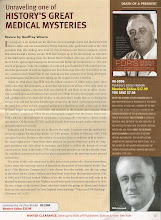
First of all, I would like to offer my sincere thanks to all of the fine people at Lahey, especially John Libertino, Lisa Polacke, for their hospitality and kindness in putting together a most pleasurable event last weekend. The star of the show was the Lahey Memorandum, the document rescued from destruction through the efforts of Dr. Harry Goldsmith, who was also in attendance. Now lets dissect what the memorandum really says and means.
The two previous posts are required reading.
The first question is why one of the world's pre-eminent surgeons is prognosticating on a cardiac diagnosis, especially so since the notion of hypertension even being dangerous at the time was not widely accepted?This is coupled with the fact that FDR had a serious abdominal problem in April 1944, well documented by Howard Bruenn in 1970, that was not seen or mentioned by Lahey.
Strange indeed.
As I have previously written, Bruenn likely conferred with Lahey over the wording of the memorandum and his 1970 whitewash was purposely designed to be compatible with it. Bruenn surely did not want to be caught in his lie if it came out. He undoudtedly knew about it. The deal was the following: Lahey and McIntire were long standing associates in FDR's treatment and when Lahey expressed concerned about his reputation and place in history. Mcintire recognized this as legitimate. The only continginency was that he could not mention the real reason for the prognosis- FDR's Deadly Secret.
The other interesting aspect of the document is that when it was finally turned over to Linda Strand by the law firm of Herrick and Smith, it was a copy. The original had been "stolen"! John Libertino believes that McIntire, who knew attorney Hanify, destroyed it. He has a hand-written letter from H &S attorney Edward B. Hanify stating that he did not know where the document was. My take was that Howard Bruenn was the culprit. Regardless, Mrs. Strand verified that the copy was indeed from the original.
The other mystery is Lahey's reference to a "trip to Russia". This did not occur until February 1945, long after the July 1944 date of the document. Roosevelt last trip across the Atlantic was Teheran in November 1943. He was also in Casablanca in January 1943, when Mcintire imposed a strict 8000 feet altitude restriction on his flight to protect his heart (a problem he allegedly didn't have until March 1944!).
Oh! What a tangled web we weave!!!
Others beside me know the truth of all this, likely told of it by Howard Bruenn himself. The family's silence is deafening. The ghost of the most powerful man of the twentieth century continues to prevail.








